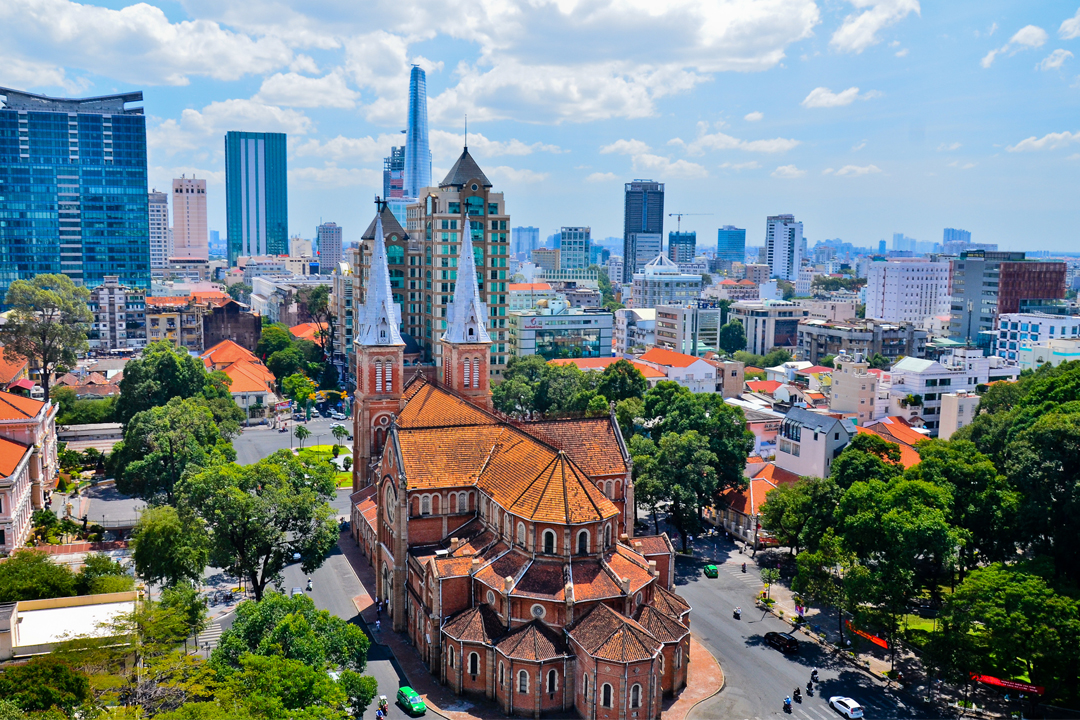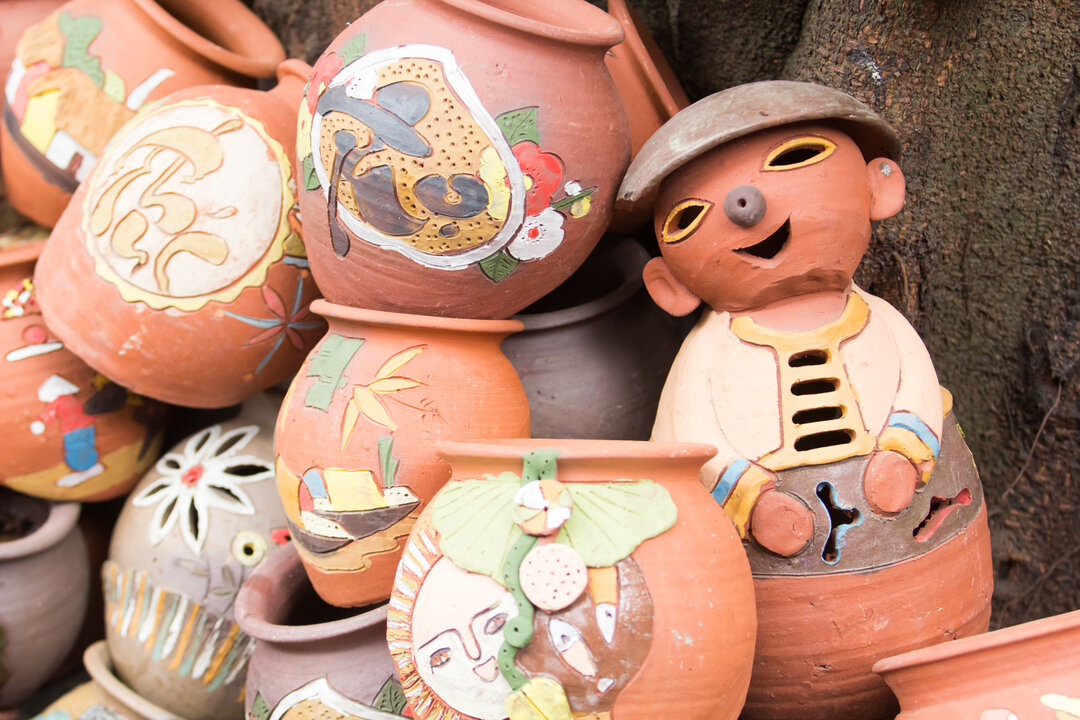Bat Trang Ceramic Village: Overview, History, Things to Do & Travel Guide
Nestled along the banks of the Red River, Bat Trang Ceramic Village stands as a testament to Vietnam’s centuries-old pottery craftsmanship. For over 500 years, artisans here have transformed rich alluvial clay into exquisite ceramics, blending tradition with evolving artistic expression. Beyond its iconic teapots and vases, Bat Trang is a living cultural archive, where each kiln fire and brushstroke reflects heritage, innovation, and resilience.
Stepping into Bat Trang is about shopping for souvenirs, it’s about immersing yourself in a world where history meets creativity. If you're an art enthusiast, a history buff, or a traveler seeking unique experiences, Bat Trang has something to captivate you.
So, what makes Bat Trang Ceramic Village so special? And how has this village maintained its artistic identity for centuries? Let’s dive into the history, techniques, and must-visit spots that define this timeless destination.
Overview of Bat Trang Ceramic Village
Location: Gia Lam Commune, along the banks of the Red River, about 14 kilometers from the center of Hanoi
This strategic location has played a crucial role in the village’s long-standing success:
- Proximity to Hanoi: Easy access for both tourists and traders.
- Red River’s clay deposits: The high-quality clay found along the river has been essential for crafting fine ceramics.
- Trade and transportation: Historically, the village benefited from waterway trade routes, allowing its products to reach markets across Vietnam and beyond.
Today, you can reach Bat Trang via road or by taking a boat trip along the Red River, which offers a scenic approach to the village. The area's accessibility makes it one of the most convenient day-trip destinations from Hanoi.
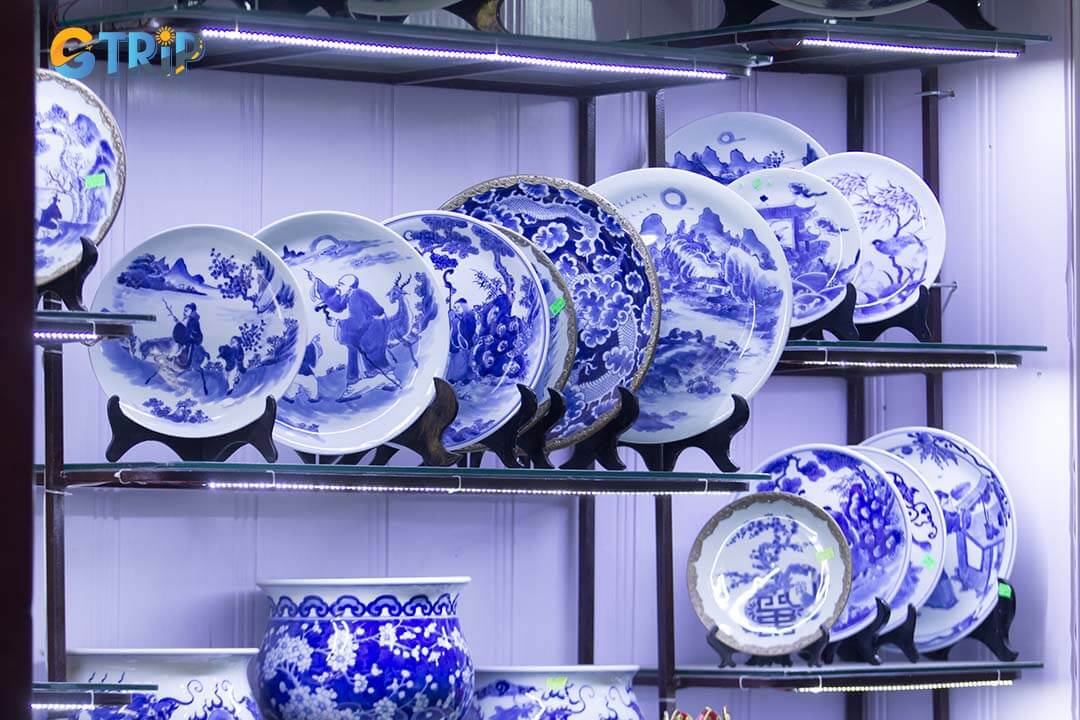
Bat Trang Village thrives on its rich clay resources, historic trade routes, and easy accessibility for visitors
What is Bat Trang Ceramic Village?
Bat Trang Ceramic Village is one of Vietnam’s most famous traditional craft villages, specializing in high-quality pottery and ceramics. Established over 500 years ago, the village has preserved and evolved its ceramic-making techniques, blending heritage with modern creativity. It serves as a historical site and an active production hub where artisans create everything from household pottery to intricate decorative pieces.
Bat Trang’s ceramics are known for their durability, unique glaze techniques, and artistic value. The village supplies domestic and international markets, maintaining its reputation as a key center of Vietnamese craftsmanship. Unlike many other craft villages that have faded over time, Bat Trang continues to thrive, adapting to contemporary demands while keeping its traditional identity intact.
Why is Bat Trang famous?
Bat Trang is renowned for its exceptional ceramic artistry, deep historical significance, and lasting contribution to Vietnam’s cultural heritage. For centuries, artisans here have perfected traditional techniques such as hand-molding, wheel-throwing, and unique glazing methods like celadon and crackled glaze. The village produces a diverse range of high-quality pottery, from household items like bowls and teapots to decorative vases and religious artifacts. Its ceramics are highly sought after both domestically and internationally, reaching markets in Japan, South Korea, the United States, and Europe. By preserving traditional craftsmanship while embracing modern innovation, Bat Trang has solidified its reputation as a leader in the ceramic industry.
Beyond its production, Bat Trang is also a cultural and tourist destination, offering visitors an immersive experience of Vietnam’s pottery heritage. Tourists can explore the Bat Trang Pottery Museum, a striking architectural landmark, or visit the 200-year-old Van Van Ancient House, home to antique ceramic artifacts. Interactive pottery workshops allow guests to shape and paint their ceramic pieces, creating a unique connection to the craft. More than a pottery village, Bat Trang embodies Vietnam’s artistic heritage, blending history, creativity, and craftsmanship.
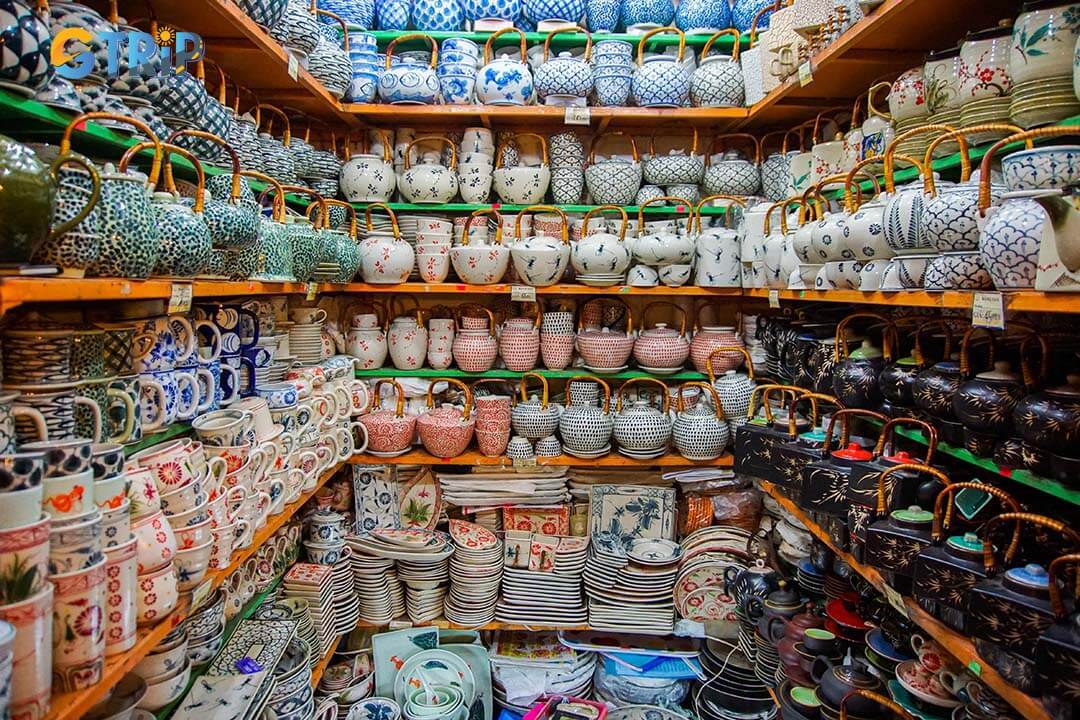
Bat Trang is a historic pottery village known for its masterful ceramics, blending tradition and innovation while serving as a cultural and tourist destination
The history of Bat Trang Ceramic Village
Bat Trang Ceramic Village is Vietnam’s most renowned pottery hub with a history dating back nearly 1,000 years. Established during the 11th century under the Ly Dynasty, the village has continuously evolved, adapting to changing artistic influences, technological advancements, and global trade while preserving its traditional craftsmanship.
- 11th century: Bat Trang's ceramic tradition began in the 11th century when artisans from Bo Bat migrated to the village, attracted by its high-quality clay and strategic location along the Red River. Initially, production focused on serving the royal court, aristocrats, and religious institutions.
- 15th-16th century: Under the Mac Dynasty, open trade policies fueled economic growth, allowing Bat Trang ceramics to flourish. Products were widely distributed across northern Vietnam, with high-ranking officials and nobility, including Princess Phuc Trang and Duke Ngan, among its patrons. Many ceramic pieces from this period bear inscriptions with details about their creators and buyers.
- 16th-17th century: European maritime expansion and China’s restrictions on private overseas trade created opportunities for Bat Trang ceramics to enter Southeast Asian and Japanese markets. Even after China eased restrictions in 1567, bans on certain exports to Japan strengthened Vietnam-Japan trade, further increasing demand for Bat Trang products. The Qing Dynasty's renewed trade bans in 1644 reduced Chinese competition, allowing Bat Trang ceramics to thrive internationally.
- Late 17th - Early 18th century: The lifting of China’s maritime trade ban in 1684 led to an influx of high-quality Chinese ceramics into Southeast Asia, reducing the market share of Bat Trang exports. Additionally, Japan, after a period of isolation, successfully developed its ceramic industry, decreasing its reliance on imported goods. These factors contributed to a decline in Bat Trang’s foreign trade.
- 18th-19th century: Vietnam’s restrictive trade policies under the Trinh and Nguyen rulers, combined with the rise of Western industrial production, further weakened ceramic exports. Many pottery villages, such as Chu Dau-My Xa, ceased production, but Bat Trang remained resilient due to strong domestic demand for household items, religious objects, and construction materials. Despite a decline in exports, the village continued to be a major center for traditional Vietnamese pottery.
- 19th century - present: During the French colonial period, Bat Trang ceramics faced competition from imported goods but maintained steady production. In 1957, landowners from Giang Cao established Truong Thinh Ceramics, laying the groundwork for the Bat Trang Porcelain Factory. After 1986, Vietnam’s shift to a market economy led to the dissolution of cooperatives and the rise of private enterprises and family-run workshops. Today, Bat Trang is a renowned ceramics hub, blending tradition with modern innovation, exporting globally, and preserving Vietnam’s rich ceramic heritage.
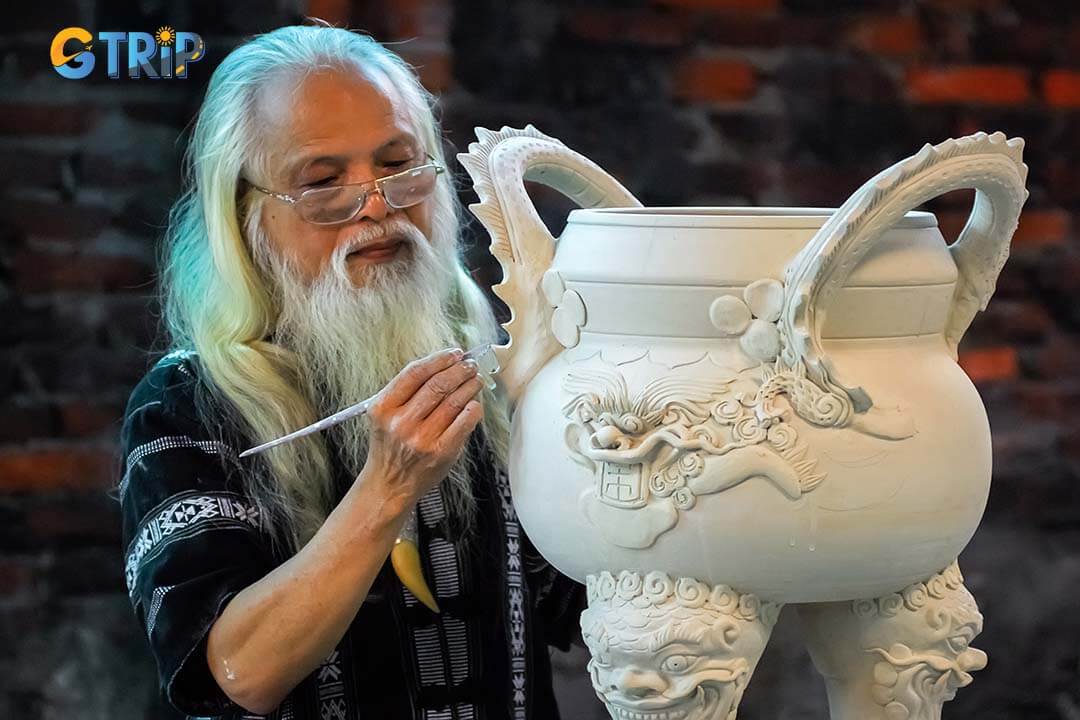
Bat Trang Ceramic Village blends tradition with innovation, evolving from a royal pottery hub to a global ceramics center
Traditional pottery techniques and artisan craftsmanship in Bat Trang
Bat Trang Ceramic Village is a living testament to Vietnam’s centuries-old pottery craftsmanship. The artisans here employ a blend of time-honoured techniques and modern refinements to produce ceramics known for their durability, elegance, and intricate designs. The production process is meticulous, involving multiple stages from clay preparation to kiln firing.
Clay sourcing and preparation
The foundation of Bat Trang ceramics lies in the high-quality clay sourced from the Red River Delta. This natural clay is rich in kaolinite, making it ideal for ceramic production due to its plasticity and ability to retain intricate details during shaping. The preparation process includes:
- Clay extraction: Traditionally sourced from the Red River’s alluvial deposits, ensuring fine-grained, mineral-rich material.
- Sedimentation and purification: The clay is soaked in water, allowing impurities to settle, leaving only the finest particles.
- Aging and kneading: The purified clay is aged for weeks to enhance its workability, then kneaded to remove air bubbles, preventing cracks during firing.
Shaping techniques
Artisans in Bat Trang employ both hand-molding and wheel-throwing techniques, depending on the complexity and scale of the product.
- Hand-molding: Used for intricate decorative items, sculptures, and bespoke designs. Skilled artisans shape the clay manually, ensuring unique, handcrafted details.
- Wheel-throwing: This traditional method involves spinning clay on a potter’s wheel, allowing for uniform shapes like vases, bowls, and teapots. The artisan controls the thickness and form through precise hand movements.
Modern advancements have introduced mechanical wheels for increased efficiency, but many artisans still prefer traditional foot-powered wheels to maintain authenticity. This balance between tradition and innovation ensures that Bat Trang ceramics retain their distinctive character while meeting contemporary demands.
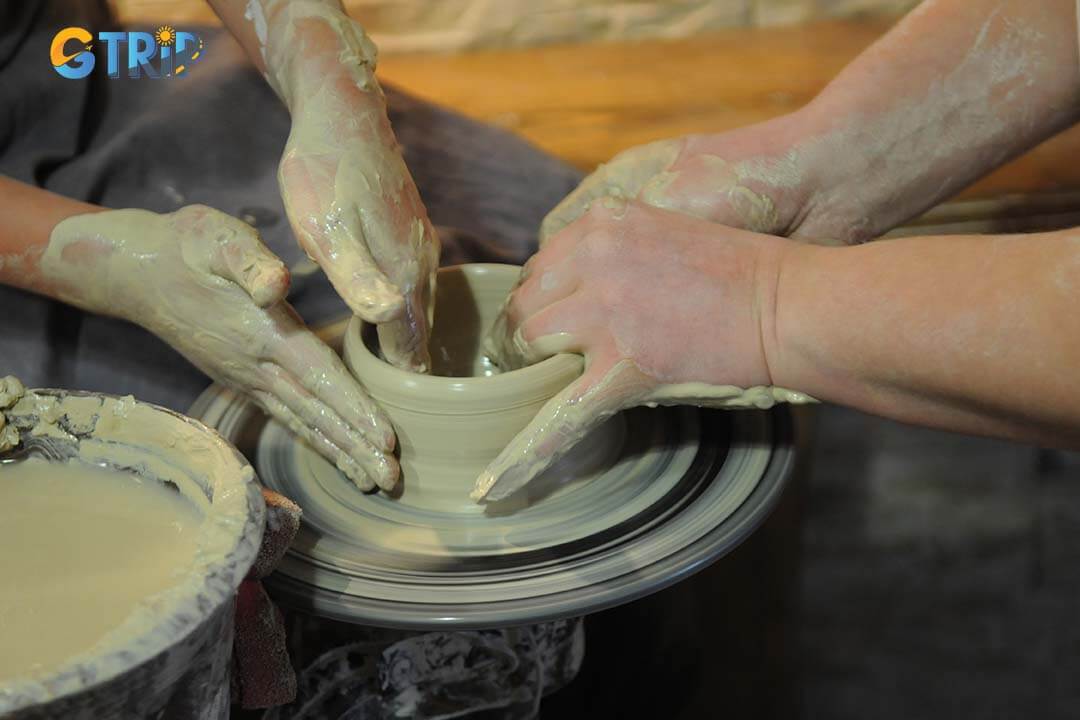
Bat Trang artisans blend tradition and innovation, using both hand-molding and wheel-throwing techniques to craft intricate, high-quality ceramics
Decoration methods
Bat Trang ceramics are revered for their artistic decorations, employing techniques such as:
- Glazing: A protective layer is applied to the surface, creating a smooth, glossy finish. Traditional glazes include celadon (greenish), white, and crackle glaze.
- Hand-painting: Artisans use natural mineral pigments to create intricate patterns, often depicting dragons, lotus flowers, or traditional Vietnamese motifs.
- Carving: Some ceramics feature delicate incised designs, achieved by engraving patterns into the clay before firing.
Kiln firing process
The final stage involves firing the ceramics at extremely high temperatures (1,200-1,300°C), solidifying their structure and enhancing durability. Bat Trang uses two primary kiln types:
- Traditional wood-fired kilns: These kilns provide a distinctive, rustic finish, often creating unpredictable color variations due to ash and flame exposure. The firing process takes several days, requiring careful monitoring.
- Modern electric kilns: Used for mass production, offering consistent temperature control and efficiency. These kilns produce more uniform pieces, but some artisans argue they lack the unique character of wood-fired ceramics.
Despite modernization, Bat Trang artisans continue to uphold their rich heritage, blending traditional craftsmanship with contemporary innovations. Their dedication ensures that Bat Trang ceramics remain a cultural treasure of Vietnam and a globally recognized symbol of exquisite artisan pottery.
7 things to do in Bat Trang Ceramic Village
You can explore a blend of heritage, hands-on experiences, and vibrant local culture at Bat Trang Ceramic Village. Below are the top 7 things to do when visiting Bat Trang.
1. Stroll through Bat Trang Ancient Village
Bat Trang Ancient Village is a must-visit destination that embodies the essence of this traditional craft village. Walking through its narrow alleys, visitors experience the serene charm of century-old red-brick houses, mossy gates, and traditional Northern Vietnamese architecture. The village is home to artisan studios where skilled craftsmen shape pottery by hand, offering a glimpse into the meticulous process of ceramic making. You can discover scenic spots and meet artisans to explore Bat Trang's rich craft history.
2. Join a hands-on pottery workshop
One of the most popular activities in Bat Trang is participating in a pottery-making class.
- Learn the traditional moulding techniques passed down through generations.
- Get hands-on with shaping, carving, and painting your ceramic piece.
- Take home your handcrafted souvenir, making the experience both educational and memorable.
Workshops are available at many artisan studios and family-run kilns. Prices typically range from 20,000 to 100,000 VND, depending on the activity. A ceramic-making session costs about 20,000 VND. If you want to take home a handmade item, the price ranges from 35,000 to 50,000 VND per piece. Painting or decorating your ceramic piece costs around 5,000 to 15,000 VND, depending on the size and design.
*Note: Ticket price is for reference only, because depending on the time, the ticket price will change.*
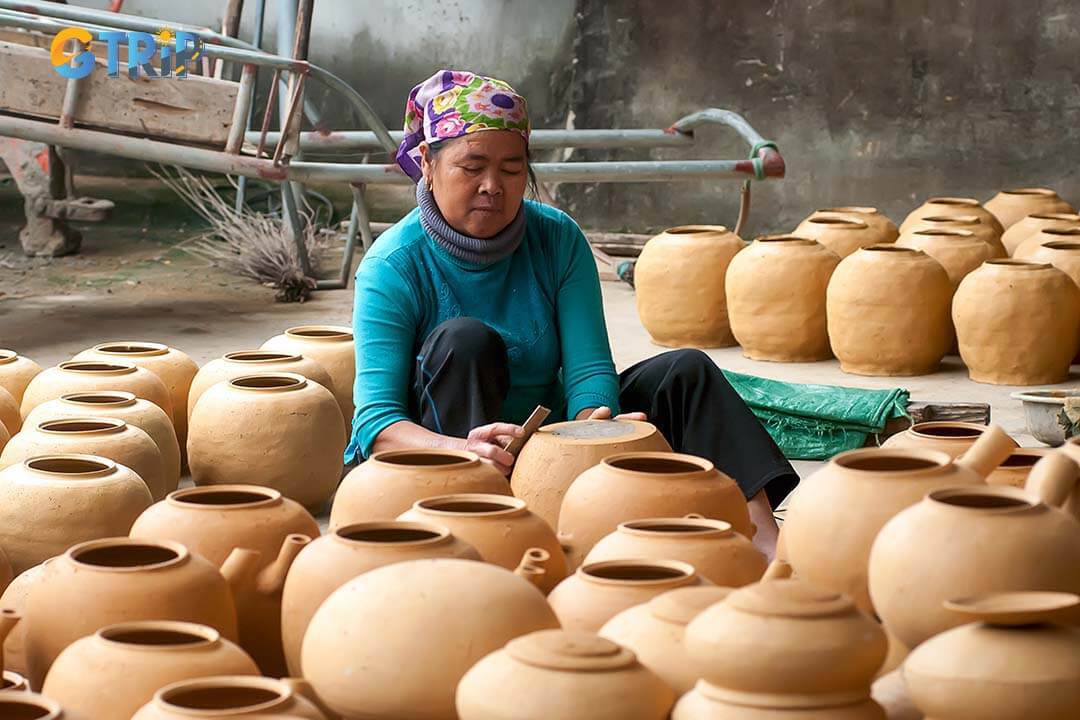
Join a pottery-making class in Bat Trang to shape, carve, and paint your own ceramic piece, creating a unique hands-on souvenir
3. Explore the Bat Trang Ceramic Market
The Bat Trang Ceramic Market is a must-visit for those seeking authentic handmade pottery. Here, tourists can browse a vast selection of ceramics, from teapots and vases to intricate ceramic paintings. Many shops offer live pottery demonstrations, providing insight into the craft. Bargaining is common, so don’t hesitate to negotiate for a better price.
For high-value ceramics, look for certified artisan seals to ensure authenticity. The market is a shopping destination and a cultural experience, where you can interact with artisans and learn about traditional techniques. With its vibrant atmosphere and diverse offerings, it’s the perfect place to find unique souvenirs or decorative pieces that reflect Vietnam’s rich ceramic heritage.
4. Discover Van Van Ancient House
The Bat Trang Ceramic Market is a must-visit for those seeking authentic handmade pottery, with a history spanning over 200 years. Tourists can explore a vast selection of ceramics, from teapots and vases to intricate ceramic paintings, along with stunning works such as dragon vases, blue-glazed teapots, and traditional ceramic molds. Many shops offer live pottery demonstrations, providing insight into the craft. Bargaining is common, so don’t hesitate to negotiate for a better price.
For high-value ceramics, look for certified artisan seals to ensure authenticity. More than just a shopping destination, the market offers a cultural experience where you can interact with artisans and learn about traditional techniques. With its vibrant atmosphere and diverse offerings, it’s the perfect place to find unique souvenirs or decorative pieces that reflect Vietnam’s rich ceramic heritage.
5. Participate in the Bat Trang Craft Village Festival
The Bat Trang Craft Village Festival is a time-honored event celebrating the village’s rich pottery heritage and honoring its ancestral artisans. Held annually on the 14th and 15th of the second lunar month at Bat Trang Communal House, the festival starts with a water procession and incense offering to honor the craft’s founders.
Tourists can immerse themselves in the festive atmosphere with traditional performances, lion dances, and vibrant parades. A highlight of the event is the live ceramic-making competitions, where skilled artisans demonstrate their craftsmanship. The festival also features exhibitions showcasing exquisite ceramic works. It allows you to admire and purchase handcrafted pieces while experiencing Bat Trang’s unique cultural traditions.

The Bat Trang Craft Village Festival honors the village’s pottery heritage with rituals, performances, and live ceramic-making competitions
6. Discover Bat Trang Pottery Museum
Bat Trang Pottery Museum is a cultural landmark that seamlessly blends modern architecture with traditional heritage. Designed to resemble seven giant pottery wheels, the museum itself is an architectural masterpiece. It features six levels, five floors and a ground level each offering a unique perspective on Bat Trang’s renowned ceramic craft. Tourists can explore interactive exhibits detailing the village’s history, ceramic-making techniques, and the evolution of its pottery tradition.
Each floor presents a different experience, from historical displays to contemporary ceramic art. The ground floor offers a hands-on pottery-making area, while the upper floors feature art exhibitions, cultural showcases, and a tranquil tea ceremony space. The museum also hosts rotating exhibitions and workshops, providing a dynamic experience for pottery enthusiasts and cultural explorers alike. Open from 8:00 AM to 5:30 PM on weekdays, with extended hours on weekends, it is an unmissable destination for those looking to immerse themselves in Vietnam’s rich ceramic heritage.
7. Enjoy the atmosphere of beliefs at Bat Trang Temple
Bat Trang Temple is a revered spiritual and historical site where artisans honor their ancestors and seek blessings for prosperity and success in their craft. The temple serves as a cultural hub, hosting traditional ceremonies and gatherings that reinforce the village’s deep connection between craftsmanship and faith. Its architecture showcases intricate wood carvings, ornate altars, and sacred calligraphy, reflecting Vietnam’s artistic heritage. During major festivals, the temple comes alive with prayers, processions, and performances, offering visitors a glimpse into Bat Trang’s rich spiritual and artistic traditions.
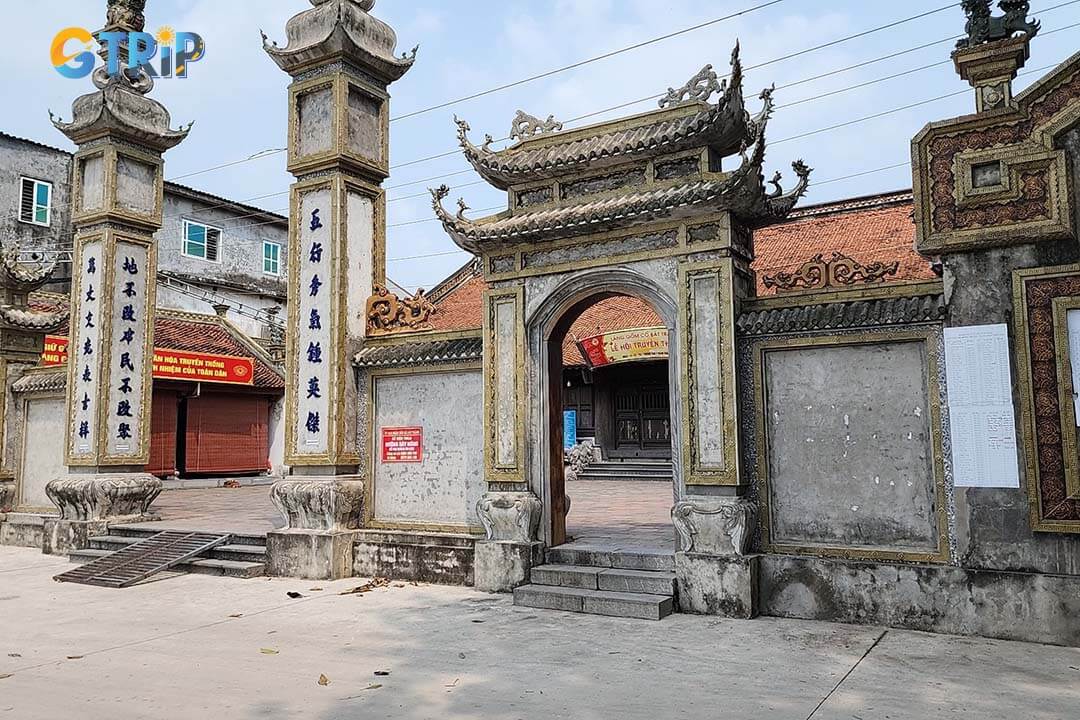
Bat Trang Temple is a sacred site where artisans honor their ancestors, blending spirituality with the village’s rich ceramic heritage
When is the best time to visit Bat Trang Ceramic Village?
Bat Trang Ceramic Village welcomes visitors year-round, offering a glimpse into its centuries-old pottery tradition. However, the best time to explore this charming village is during the dry season, from October to April, when the weather is pleasant and ideal for outdoor activities. This period allows visitors to stroll through its narrow alleys and participate in hands-on pottery-making experiences without the inconvenience of rain. Visiting during this period allows you to fully appreciate the village’s cultural heritage without the inconvenience of rain, which can make getting around more challenging.
For a deeper cultural immersion, consider visiting on the 14th and 15th days of the second lunar month, when the annual Bat Trang Craft Village Festival takes place. This vibrant event features traditional ceremonies, pottery-making competitions, and cultural performances that showcase the village’s artistic legacy. It is a unique opportunity to witness the deep connection between spirituality and craftsmanship while joining locals in honoring their ancestors and trade. If you visit during the dry season or the festival, Bat Trang promises an enriching experience filled with history, art, and cultural discovery.
How to get to Bat Trang from Hanoi?
Bat Trang Ceramic Village is located about 14 km from Hanoi in Gia Lam District, making it an easy and accessible day trip for both locals and tourists. Travelers can choose from public transportation, self-driving options, or guided tours, depending on their budget and convenience.
1. By public bus (Cheapest option)
Hanoi’s bus system offers a direct and affordable route to Bat Trang:
- Bus 47A: Departs from Long Bien Bus Station and stops directly at Bat Trang Village.
- Ticket price: Around 7,000 VND ($0.30 ) per trip.
- Travel time: Approximately 40-50 minutes.
2. By taxi or ride-hailing apps (Fastest & most convenient)
- Taxi: Popular companies like Mai Linh, Vinasun, and G7 offer direct rides.
- Grab/Be/XanhSM: Vietnam’s ride-hailing apps provide motorbike and car services at competitive prices.
- Estimated fare:
- Taxi: 200,000 - 300,000 VND ($8-12) per trip.
- GrabCar: 150,000 - 250,000 VND ($6-10).
- Travel time: 40-50 minutes, depending on traffic.
3. By motorbike rental (It is not recommended if you are unfamiliar with Vietnam's traffic laws)
Motorbikes provide flexibility and allow travelers to explore beyond Bat Trang.
- Rental cost: 120,000 - 200,000 VND ($5-8) per day.
- Where to rent:
- Hanoi Old Quarter rental shops (Tigit Motorbikes, Rent A Bike Vietnam).
- Some hotels and hostels also offer motorbike rentals.

Bat Trang Ceramic Village is a convenient day-trip destination with multiple transport options
What to eat in Bat Trang Village?
Bat Trang is famous for its centuries-old pottery and its unique local cuisine. Here are some must-try dishes when visiting the village:
1. Banh khoai mi nuong (Grilled cassava cake)
This rustic yet delicious snack is made from finely grated cassava mixed with coconut milk and sugar, then shaped into round cakes and grilled over hot charcoal. The result is a crispy, golden-brown crust with a soft, chewy interior, carrying a rich coconut aroma. It’s best enjoyed warm, making it a perfect treat on a cool day.
2. Banh te nong (Steamed rice cake)
A Northern Vietnamese specialty, banh te nong features rice flour wrapped around a savory filling of minced pork and mushrooms. The cake is wrapped in banana leaves and steamed to perfection, resulting in a soft, fragrant texture. It is typically served with a side of sweet and sour fish sauce, enhancing the overall flavor.
3. Canh mang muc (Squid bamboo shoot soup)
A signature dish of Bat Trang, this soup is a harmonious blend of tender squid and crunchy bamboo shoots, simmered in a flavorful broth. The squid is carefully prepared to maintain its chewy yet tender texture, while the bamboo shoots add a refreshing crispness. This dish is often served during special occasions and family gatherings.
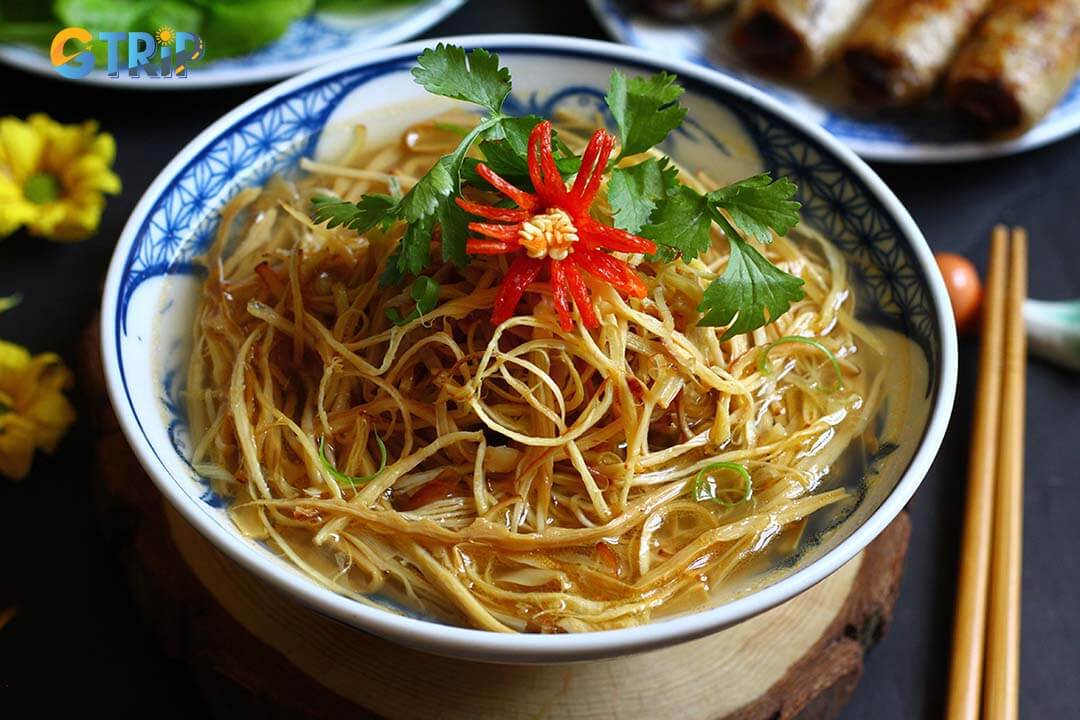
Bat Trang’s signature squid and bamboo shoot soup offers a rich, savory broth with tender squid and crunchy bamboo shoots, perfect for special occasions
4. Che hat hoa soi (Jasmine seed sweet soup)
This unique dessert is infused with the delicate fragrance of jasmine flowers, creating a light and refreshing sweetness. Made with jasmine seeds, lotus seeds, and mung beans, this dish is both a delicious treat and a soothing drink, often enjoyed as a cooling remedy during hot summer days.
5. Oi Dong Du (Dong Du Guava)
Dong Du Guava, grown in the nearby Dong Du area, is famous for its small size, crisp texture, and naturally sweet taste. It is often enjoyed fresh or served with a mixture of salt and chilli, enhancing its flavor. This fruit is a favorite snack for both locals and visitors.
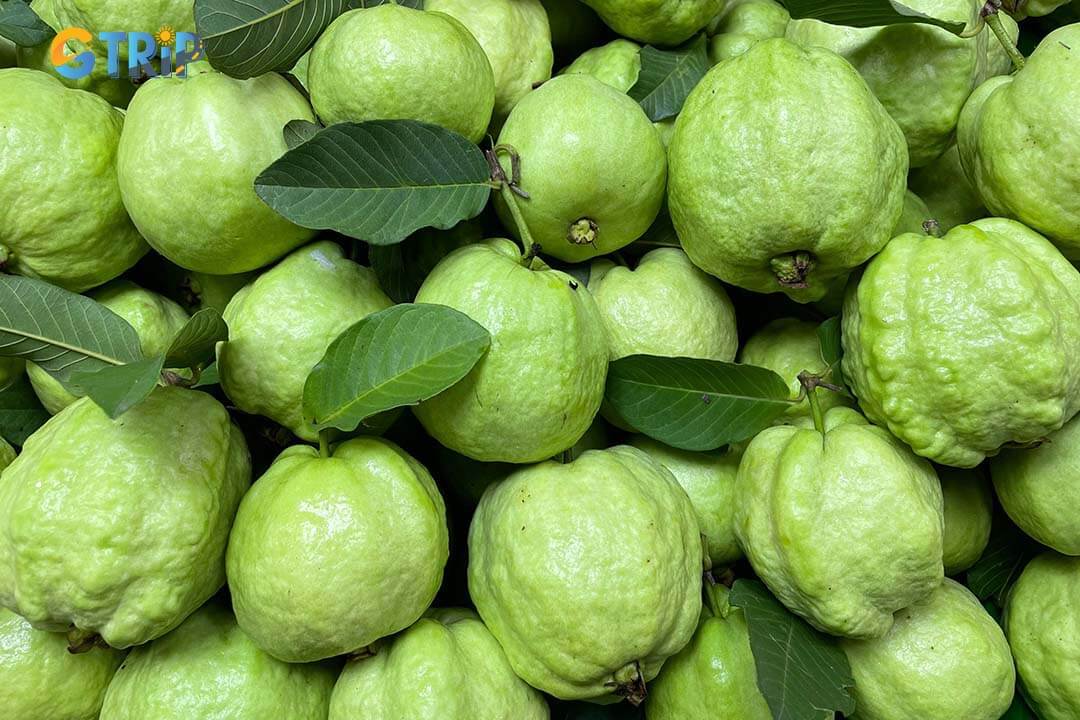
Dong Du Guava is a small, crispy, and naturally sweet local delicacy, often enjoyed fresh or with salt and chili
From savory delights to sweet treats, Bat Trang Village offers a variety of local flavors that add to the charm of this traditional craft village. Don't miss the chance to taste these specialties during your visit!
Recommended restaurants and eateries
While Bat Trang is a small village, there are several restaurants and eateries where visitors can enjoy a sit-down meal with authentic flavors.
| Restaurant name | Specialty dishes | Location |
|---|---|---|
| Hoa Vien - Bat Trang Restaurant | Traditional Vietnamese home-style meals | No. 1 Bat Trang Industrial Park, Bat Trang Commune, Gia Lam District, Hanoi |
| Du thuyen Hai Hung Restaurant | Grilled river fish, seafood | 100 Bat Trang Street, Bat Trang, Gia Lam, Hanoi |
| Am thuc Bat Trang Ancient Village Hoa Thu | Chicken, shrimp rolls, spring rolls, dried squid with kohlrabi, 2 bowls of soup, sticky rice with tea | Lang co 1, Ng.72, Bat Trang, Gia Lam, Hanoi |
Travel tips for visiting Bat Trang Ceramic Village
Visiting Bat Trang Ceramic Village can be a fascinating experience, but to make the most of your trip, it's essential to plan. Here are some expert travel tips to ensure a smooth and enjoyable visit.
Essential dos and don’ts
Dos:
- Respect local artisans: The villagers take great pride in their centuries-old craftsmanship. When visiting pottery workshops, observe with appreciation and ask for permission before touching fragile ceramic pieces.
- Negotiate wisely: Bargaining is common in the local markets, but do so respectfully. Start with a lower offer and meet the seller at a fair price.
Don'ts:
- Avoid mass-produced ceramics: Some vendors sell factory-made ceramics that lack the authenticity of handcrafted Bat Trang pottery. Look for handmade details like slight imperfections or the artisan’s signature.
- Beware of tourist scams: Some unofficial tour guides may overcharge for services or take you to overpriced shops where they receive commissions. Stick to reputable guides or explore independently.
Packing tips for a day trip
To ensure a comfortable visit to Bat Trang, pack the following essentials:
- Comfortable clothing: The village involves a lot of walking, so wear breathable clothes and comfortable shoes.
- Cash in Vietnamese Dong: Many small vendors do not accept credit cards, so bring cash for purchases and entrance fees.
- A camera or phone: Bat Trang offers many Instagram-worthy spots, from ancient alleys to pottery workshops.
- Reusable shopping bag: If you plan to buy ceramics, carry a sturdy bag to transport fragile items safely.
- Sunscreen and hat: If visiting during summer, protect yourself from the heat as some areas have limited shade.
Common tourist mistakes to avoid
- Rushing through the village: Many tourists make the mistake of only visiting the market area. To truly experience Bat Trang, take time to explore pottery-making workshops and historical sites like the Van Van Ancient House.
- Skipping the pottery workshop: Hands-on experiences are one of the village’s highlights. Join a pottery-making session to mould and paint your ceramic piece.
- Visiting at peak hours: Mornings and early afternoons tend to be crowded with tour groups. For a more relaxed experience, visit early in the morning or late in the afternoon.
- Not securing fragile purchases properly: If buying ceramics, ask the vendor for extra padding and consider bringing bubble wrap for added protection.

By following these expert tips, you can enjoy an enriching and memorable visit to Bat Trang Ceramic Village
FAQs - What do travelers want to know about Bat Trang Ceramic Village?
Bat Trang Ceramic Village, with its deep-rooted history and thriving pottery craftsmanship, attracts numerous travelers eager to explore its heritage. Below are some frequently asked questions that can help visitors plan their trip effectively.
Can you ship ceramics internationally from Bat Trang Ceramic Village?
Yes, many ceramic shops and workshops in Bat Trang offer international shipping services, allowing visitors to bring home exquisite pottery. Shipping costs vary based on the destination, weight, and fragility of the items, so it's essential to inquire in advance. Most reputable shops ensure professional packaging using bubble wrap, foam padding, and sturdy wooden crates for fragile or oversized pieces. Common courier services include Vietnam Post, DHL, FedEx, and UPS, offering both standard and express shipping options. However, buyers should check local customs regulations, as some countries impose restrictions on importing ceramics, particularly antiques or hand-painted items. Additionally, not all vendors provide refunds for damaged shipments, so it’s advisable to ask about insurance coverage before finalizing a purchase.
How much time should you spend in Bat Trang Ceramic Village?
The ideal time to spend in Bat Trang depends on the type of experience you seek. Here’s a general guideline:
| Duration | Recommended activities |
|---|---|
| 2-3 hours | Visit the ceramic market, buy souvenirs, and take a short walk around the village. |
| Half-day (4-5 hours) | Explore the Bat Trang Pottery Museum, visit Van Van Ancient House, and enjoy a hands-on pottery workshop. |
| Full-day trip | Experience everything: take a guided tour, make your pottery, shop for ceramics, and explore the surrounding Red River Delta area. |
| Overnight stay | For in-depth exploration, some homestays offer extended workshops and cultural experiences, allowing visitors to truly immerse themselves in the local lifestyle. |
Bat Trang Ceramic Village is more than just a centuries-old pottery hub - it’s a living testament to Vietnam’s rich artisanal heritage. From the intricate craftsmanship of handmade ceramics to the immersive hands-on experiences, this village offers visitors a deep dive into traditional pottery-making while also embracing modern artistry.
If you're an art enthusiast, a history buff, or simply looking for unique handcrafted souvenirs, Bat Trang has something for everyone. By understanding its cultural significance, exploring its workshops, and supporting local artisans, you become part of preserving this remarkable tradition. If you want to explore more famous cultural gems in Vietnam, check out our Hanoi Tours on GTrip - Vietnam Travel Agency.



